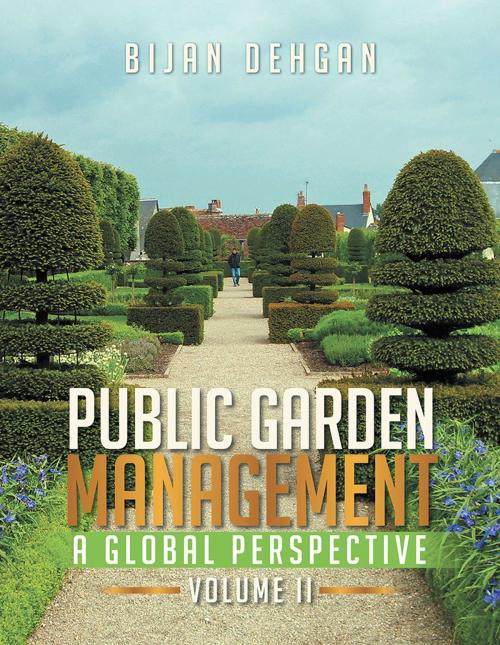| Author: | Bijan Dehgan | ISBN: | 9781493161836 |
| Publisher: | Xlibris US | Publication: | April 16, 2014 |
| Imprint: | Xlibris US | Language: | English |
| Author: | Bijan Dehgan |
| ISBN: | 9781493161836 |
| Publisher: | Xlibris US |
| Publication: | April 16, 2014 |
| Imprint: | Xlibris US |
| Language: | English |
Public Gardens Management: A Global Perspective provides essential information about public gardens and what is involved in designing, managing, and maintaining one. Although suitable as a textbook, its audience will include anyone with direct or peripheral responsibility for administration or supervision of a complex organization that requires scientific knowledge as well as public relations and business acumen. It may also prove useful for homeowners, for there is no fundamental difference between growing plants in a public garden or a home garden, a fact reflected in the extensive reference citations. The topic is multidisciplinary and as old as the beginning of human civilization when the concept of mental and physical restoration was realized by early man while he/she was in a natural but well-ordered garden environment. Thus began the art of garden making. Many volumes have been written on every applicable subject discussed in this and similar publications. Indeed the voluminous literature on history, design, horticulture, and numerous related subjects is nothing short of overwhelming. Accordingly, anyone involved in management of public gardens, whether as a director or area supervisor, and irrespective of the type and size of such facility, would have to have familiarity with various aspects of garden organization and administration. However, despite the enormous number and diversity of such publications there are very few books that deal with the multiplicity of the topics in such a manner as to be practical in approach and cover most relevant and unified issues in a single book. These volumes provide the essential background information on plants, animals, management, maintenance, fundraising and finances, as well as history, art, design, education, and conservation. They also cover a host of interrelated subjects and responsible organization of such activities as creating a childrens garden, horticultural therapy, conservatories, zoological gardens, and parks, hence, administration of multidimensional public gardens. Nearly 500 full color plates representing illustrations from gardens in more than 30 countries are provided to assist and guide students and other interested individuals with history and the fundamental issues of public garden management. The 15 chapters begin with the need for public gardens, types of public gardens, historical backgrounds, as well as design diversity. Numerous quotations are included from many garden lovers, landscape architects, philosophers, and others. The authors primary aim in writing this book was based on the confidence that a relevant reference, between the encyclopedic nature of some and the specific subject matter of others, could be used to provide fundamental information for management of public as well as private gardens. The boundary between botanical and zoological gardens and parks is no longer as distinct as it once was. In part it is because a garden is not a garden without plants and in part it has become apparent that for all practical intents and purposes all animals need plants for their survival. Visitors of zoological gardens expect to see more than just animals; zoos are landscaped grounds. Moreover, most communities find it financially difficult to simultaneously operate a botanical garden or an arboretum as well as a zoological garden and city parks. A number of public gardens are currently referred to as botanical and zoological garden. Population density and the publics desires and expectations, as well as financial requirements, are among the reasons for some major city parks, such as Golden Gate in San Francisco, Central Park in New York City, and Lincoln Park in Chicago which integrate botanical or zoological divisions as well as museums and recreational facilities. While this book attempts to provide basic principles involved in public garden management, it does not claim to be a substitute for broader familiarity
Public Gardens Management: A Global Perspective provides essential information about public gardens and what is involved in designing, managing, and maintaining one. Although suitable as a textbook, its audience will include anyone with direct or peripheral responsibility for administration or supervision of a complex organization that requires scientific knowledge as well as public relations and business acumen. It may also prove useful for homeowners, for there is no fundamental difference between growing plants in a public garden or a home garden, a fact reflected in the extensive reference citations. The topic is multidisciplinary and as old as the beginning of human civilization when the concept of mental and physical restoration was realized by early man while he/she was in a natural but well-ordered garden environment. Thus began the art of garden making. Many volumes have been written on every applicable subject discussed in this and similar publications. Indeed the voluminous literature on history, design, horticulture, and numerous related subjects is nothing short of overwhelming. Accordingly, anyone involved in management of public gardens, whether as a director or area supervisor, and irrespective of the type and size of such facility, would have to have familiarity with various aspects of garden organization and administration. However, despite the enormous number and diversity of such publications there are very few books that deal with the multiplicity of the topics in such a manner as to be practical in approach and cover most relevant and unified issues in a single book. These volumes provide the essential background information on plants, animals, management, maintenance, fundraising and finances, as well as history, art, design, education, and conservation. They also cover a host of interrelated subjects and responsible organization of such activities as creating a childrens garden, horticultural therapy, conservatories, zoological gardens, and parks, hence, administration of multidimensional public gardens. Nearly 500 full color plates representing illustrations from gardens in more than 30 countries are provided to assist and guide students and other interested individuals with history and the fundamental issues of public garden management. The 15 chapters begin with the need for public gardens, types of public gardens, historical backgrounds, as well as design diversity. Numerous quotations are included from many garden lovers, landscape architects, philosophers, and others. The authors primary aim in writing this book was based on the confidence that a relevant reference, between the encyclopedic nature of some and the specific subject matter of others, could be used to provide fundamental information for management of public as well as private gardens. The boundary between botanical and zoological gardens and parks is no longer as distinct as it once was. In part it is because a garden is not a garden without plants and in part it has become apparent that for all practical intents and purposes all animals need plants for their survival. Visitors of zoological gardens expect to see more than just animals; zoos are landscaped grounds. Moreover, most communities find it financially difficult to simultaneously operate a botanical garden or an arboretum as well as a zoological garden and city parks. A number of public gardens are currently referred to as botanical and zoological garden. Population density and the publics desires and expectations, as well as financial requirements, are among the reasons for some major city parks, such as Golden Gate in San Francisco, Central Park in New York City, and Lincoln Park in Chicago which integrate botanical or zoological divisions as well as museums and recreational facilities. While this book attempts to provide basic principles involved in public garden management, it does not claim to be a substitute for broader familiarity















